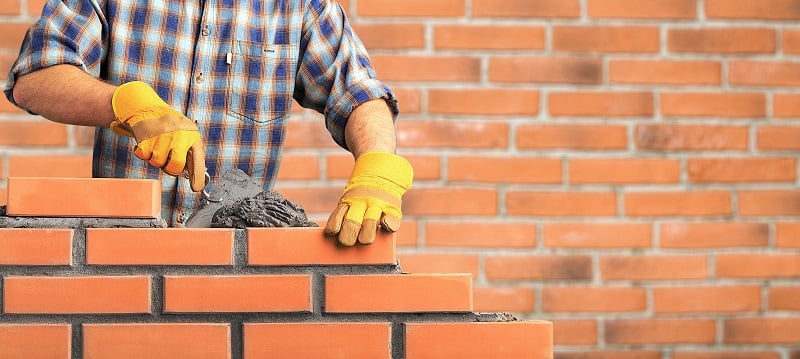Chimney Flashing and Cap Repair: Protect Your Home from Aspects
Chimney Flashing and Cap Repair: Protect Your Home from Aspects
Blog Article
Opening the Keys of Lasting Masonry Construction Practices for Eco-Friendly Structures
Among the myriad methods to environmentally friendly structure, lasting stonework building stands out as a reliable and sturdy approach that holds a wide range of untapped potential. From the selection of products to ingenious building and construction strategies, the keys to achieving sustainability within masonry construction are diverse and intriguing.
Benefits of Lasting Stonework Construction
Accepting lasting stonework construction methods not just reduces environmental effect yet also provides long-lasting financial benefits to home builders and areas. By making use of materials like recycled bricks, blocks, and rocks, builders can dramatically decrease the carbon footprint of their jobs while advertising resource effectiveness. In addition, sustainable masonry building and construction strategies, such as correct insulation and thermal mass residential properties, can boost power performance within structures, bring about minimized functional expenses with time.
Moreover, the sturdiness and durability of masonry structures contribute to long-lasting financial advantages. Structures created utilizing sustainable masonry practices typically need less repair and maintenance, converting to set you back savings for home builders and building proprietors. The durability of masonry products likewise guarantees that structures remain secure and safe, minimizing the need for frequent improvements or substitutes.
Eco-Friendly Masonry Products
Using green stonework materials is a crucial action in the direction of improving the sustainability of building practices and minimizing ecological effect while optimizing lasting economic benefits. Lasting masonry materials are sourced, produced, and made use of in a way that decreases overall ecological effect. Materials such as recycled bricks, reclaimed rock, and sustainable cinder block are becoming increasingly preferred options for eco-conscious contractors. Recycled bricks, for instance, not only draw away waste from garbage dumps yet also call for less energy to generate compared to new blocks. Reclaimed stone supplies a distinct visual allure while minimizing the requirement for new quarrying. Sustainable concrete obstructs include recycled accumulations and might feature enhanced insulation homes, adding to power efficiency in buildings.
In addition, natural materials like adobe, rammed earth, and straw bundles provide exceptional thermal mass properties, decreasing the requirement for heating and cooling down power. These products are frequently locally available, advertising local economic situations and minimizing transportation-related carbon discharges. By choosing environment-friendly stonework materials, construction tasks can dramatically lower their environmental footprint and add to the creation of healthier, much more lasting constructed settings.
Energy-Efficient Masonry Techniques
Power performance plays a vital function in enhancing the sustainability of stonework building practices. By applying energy-efficient masonry techniques, building contractors can substantially lower the general power consumption of a structure, causing lower functional costs and a smaller sized environmental impact. One essential energy-efficient stonework strategy is using thermal mass, which includes incorporating thick products like concrete or block right into the structure's structure to soak up and keep warmth. This assists manage interior temperature levels, lowering the requirement for mechanical home heating and cooling systems.

Technologies in Lasting Stonework
Recent advancements in lasting stonework methods have produced innovative methods that are reshaping the building industry. One such development is the development of self-healing concrete, which utilizes microorganisms installed within the concrete to heal cracks autonomously. This breakthrough not just decreases upkeep costs yet also boosts the sturdiness of stonework structures, adding to their sustainability.
An additional significant view website development is using recycled accumulations in masonry construction - masonry contractor. By including materials such as smashed ceramic waste or recycled glass right into concrete mixes, builders can lower the environmental impact of building and construction projects while keeping structural stability. This technique not only diverts waste from garbage dumps however also saves natural deposits, making it a key innovation in lasting masonry building
Furthermore, the combination of digital style devices, such as Building Details Modeling (BIM), is transforming the way stonework structures are prepared and constructed. BIM permits even more accurate estimations, reduced product wastefulness, and enhanced energy effectiveness, inevitably leading to even more lasting building practices. These technologies collectively represent a promising future for lasting masonry building in the era of green buildings.
Future Trends in Stonework Sustainability
With the cutting-edge strides made in lasting masonry practices, the future fads in stonework sustainability are poised to further reinvent the building and construction industry. One of the key patterns forming the future of masonry sustainability is the increased integration of innovation. Innovations such as Structure Information Modeling view it now (BIM) and virtual reality simulations are being utilized to enhance masonry building procedures, causing lowered product waste and boosted power performance in buildings.
Additionally, the growth of novel sustainable materials is readied to play a significant function in boosting the eco-friendliness of masonry construction. masonry contractor. Technologies like self-healing concrete, recycled accumulations, and bio-based binders are gaining grip for their capability to reduce ecological impact while preserving architectural integrity

Final Thought
In conclusion, lasting stonework building and construction practices use numerous advantages for environment-friendly structures. By making use of environmentally friendly products and energy-efficient techniques, stonework can add to an extra sustainable developed environment. Technologies in sustainable stonework are continually being established to additionally enhance the environmental efficiency of buildings. Looking towards the future, the fad of stonework sustainability is expected to expand, leading to more eco pleasant and view website energy-efficient building and construction practices in the years to come.
Report this page